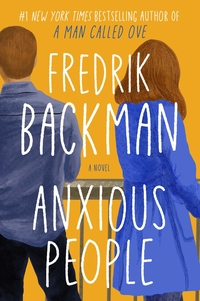Anxious People by Fredrik Backman
 Friday, September 11, 2020 at 6:34AM
Friday, September 11, 2020 at 6:34AM 
First published in Sweden in 2019; published in translation by Atria Books on September 8, 2020
Anxious People is a novel about a bank robbery that triggers a hostage drama. But no, it’s really a novel about a desperate man who jumps from a bridge and a desperate girl who doesn’t. But no, it’s not really about any of that. Fredrik Backman tells us that Anxious People is about idiots because that’s what we all are: idiots who are doing the best we can. Anxious People is a sweet, unpredictable, laugh-out-loud story of diverse individuals who begin to overcome their anxieties by recognizing the need to let go of the past while embracing a more compassionate future.
Abandoned by a spouse who had an affair and desperate for money to avoid eviction and an ensuing loss of child custody, a parent makes the unfortunate decision to rob a bank. The robbery is futile because the robber unwittingly chooses a cashless bank. The fleeing robber dashes through the nearest door and up a light of stairs where a realtor is showing an apartment. By wielding a gun that the robber assumes to be a toy, a hostage situation begins. Or maybe not, because the robber doesn’t want to frighten anyone and taking hostages was never part of the plan.
The story is driven by the quirky personalities of each person attending the apartment showing. From time to time we also encounter Jim and Jack, police officers who are father and son. Backman mixes in transcripts of Jack’s interviews with the hostages after they are released. None of the hostages are particularly good at being interviewed, but they are quite good at infuriating Jack. The interviews digress into silliness that makes a strong contribution to the story’s merriment.
As the title suggests, the characters are anxious. A couple of them are anxious to buy the apartment, but all are anxious in the sense of experiencing anxiety. They seem to be concerned about how others perceive them, taking political correctness to extremes for fear of being seen as prejudiced when they discuss gay people — except for Julia and Ro, lesbians who are expecting a child. They argue constantly, perhaps because they enjoy making up.
Competing against Julia and Ro for the apartment are Roger and Ana-Lena, an older couple who may be together as a function of habit rather than connection. Roger is obsessively competitive (he makes money by flipping apartments) while Ana-Lena feels the need to explain what Roger means every time Roger speaks.
Lennart appears in the story after he is forced out of the apartment’s bathroom because Julia needs to use it. Lennart has no pants but is wearing a rabbit head. Despite his unconventional attire, Lennart is probably the story’s most idealistic character. Apartments typically come up for sale because of death or divorce, but Lennart believes there’s something romantic about all the apartments that aren’t for sale. It is possible to imagine that they are occupied by happy couples.
Zara and Estelle have each attended the showing for reasons unrelated to a desire to purchase the property. Estelle is an older woman learning to live without her husband, a man who was everything to her despite having little in common with her. Zara, a prosperous banker who annoys her therapist, is acerbic and judgmental, making it no surprise that she’s lonely. Zara is surprised to discover a connection between her therapist and one of the other characters.
Jim and Jack love each other, as father and son should, but don’t know how to express it, as fathers and sons almost never do. Jack is among the characters who have been touched by the man who jumped from the bridge ten years earlier. Jack became a cop with the noble purpose of saving people, but it is up to his father to teach Jack that making an arrest isn’t always the best way to save someone.
The hostage drama triggers empathy in each of the characters, all of whom have at some point been frightened and lost, all of whom felt anxiety before the robber appeared. We live in a world we share with strangers who harbor the same anxieties. We brush against each other and, as Backman illustrates, we have an impact on each other in ways we may never understand.
Each character in Anxious People makes a bit of progress toward anxiety relief, because one bit at a time is all that anyone can manage. We start by admitting that there’s “an ache in our soul, invisible lead weights in our blood, an indescribable pressure in our chest,” and by recognizing that other people feel the same way. We try to internalize the belief that things we blame ourselves for are not always our fault. We make an effort to understand other people and to care about them, even if they are not like us, because caring about others is essential to caring about ourselves.
Letting go of negativity and all the unimportant things that anchor us might create anxiety in the form of uncertainty, but not knowing what happens next is a good starting point from which to build a better life. If we are nothing more than the sum of our experiences, Backman says, we could not live with ourselves. “We need to be allowed to convince ourselves that we’re more than the mistakes we made yesterday. That we are all of our next choices, too, all of our tomorrows.” Sometimes we need someone to give us a second chance. Sometimes we need to give ourselves one.
Backman keeps the reader guessing about the bank robber’s fate. Will the robber escape and, if so, how? Backman dangles possibilities to make the reader think “I know how the robber escapes” before foreclosing them. So there’s an element of mystery, but the plot exists largely to frame the characters and to showcase their anxieties and the lessons they learn. And to make the reader laugh, a goal Backman accomplishes on every page.
I suppose there’s a degree of sappiness in the self-help advice that Backman offers, but the story is told with so much heart and humor that even the most cynical reader should be able to embrace it. Whether or not a reader appreciates Backman’s lessons, it would be difficult to dislike the characters or to avoid laughing at them in recognition that they are, like us, idiots who are doing the best they can.
RECOMMENDED



